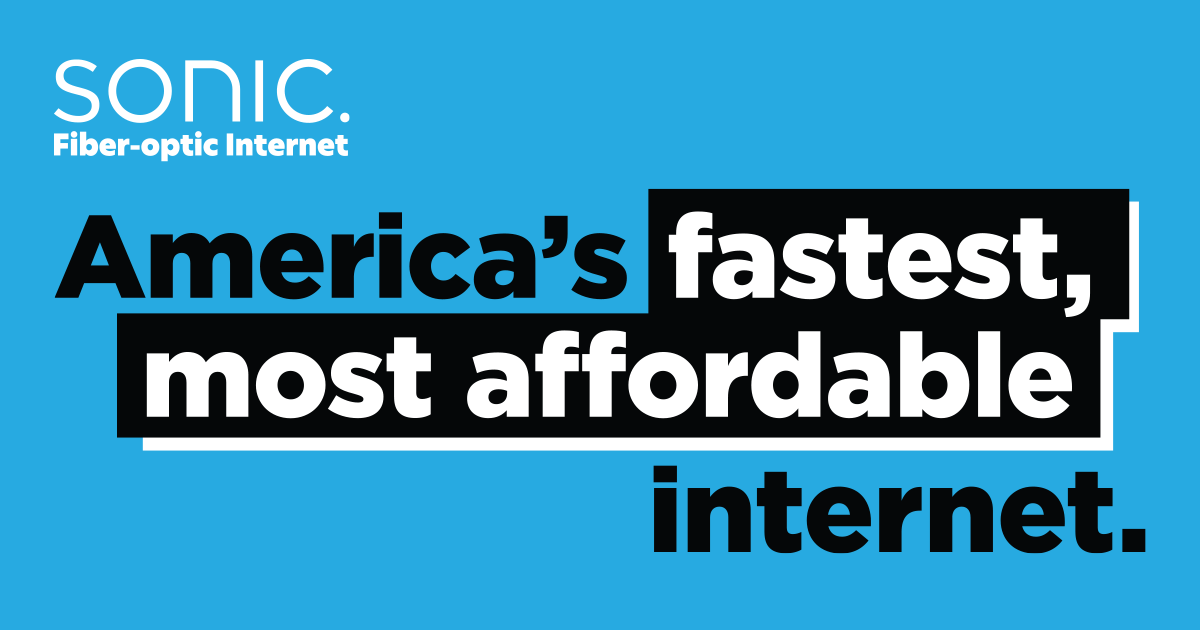Japan sets new internet speed world record — 4 million times faster than average US speeds
-
Where the hell are you getting 10Gbps for $50/mo? I'm paying $95/mo for 1Gbps

America’s fastest, most affordable internet service.
Get fiber-optic internet service with speeds up to 10 Gigabits. Fast, fair, and affordable.
(sonic.com)
I'm actually paying $40/month because I'm on a legacy plan that's $10/month cheaper in exchange for no phone or email support (SMS only) and no free addons like email, web hosting space, eFax, or VPN.
Sonic has caused the other ISPs to lower their prices here. For example, Comcast Xfinity has 2Gbps for $70/month, although that's not symmetric and only has 250Mbps upload speed. AT&T's fastest plan here is 5Gbps for $155/month.
There's a few cities throughout the US that have a similar service, or cheap municipal fiber (ran by the city itself). Unfortunately it's not very common though.
-
That sounds like a coax network instead of fiber.
It sure does, but AFAIK it was only available to houses that use fiber (FTTP - fiber to the premises) until recently. My mum could only get 250Mbps max over the coax network before (Aussies refer to it as "HFC" - hybrid fiber and coax).
They do have a 1000/250 plan but it's ridiculously expensive compared to the "standard" 1000/50 (called "NBN 1000" - NBN is the National Broadband Network)
-
Yeah Australia still hasn't quite caught up to the internet speeds some other countries had 15 years ago. It's kinda sad. I'm still sad the original (good) NBN got replaced by the janky NBN that's taken years to fix.
The other weird thing in Australia is that even the expensive fibre plans are asymmetric. Most countries that have fibre have a 1Gbps symmetric plan (meaning upload and download are both 1Gbps) whereas the 1Gbps NBN plan has a ridiculously low ~50Mbps upload speed.
I moved from Australia to the USA in 2013. Back then, I had ~9Mbps ADSL2+ in Australia, compared to 600Mbps in the USA. Huge difference. Now I've got 10Gbps symmetric in the USA for $50/month through a local ISP.
I'm still sad the original (good) NBN got replaced by the janky NBN that's taken years to fix.
Malcolm Turnbull is the one I blame most for that. It was his party's policy, but it was his charisma and perceived technology knowledge that sold it.
And he did it for the chance of being PM, not because it was the correct course of action for the betterment of the people he was supposed to be representing.
Imagine selling out an entire country's future for a promotion. What a cockhead.
-
A good point for Google
-
There really is Xkcd for everything.
-
It sure does, but AFAIK it was only available to houses that use fiber (FTTP - fiber to the premises) until recently. My mum could only get 250Mbps max over the coax network before (Aussies refer to it as "HFC" - hybrid fiber and coax).
They do have a 1000/250 plan but it's ridiculously expensive compared to the "standard" 1000/50 (called "NBN 1000" - NBN is the National Broadband Network)
My ISP used to advertise about fiber because their backend is fiber but residential connections are coax with DOCSIS whatever. One of the downsides is assymetric up/download speeds. Upload gets reduced to favour download and you get these whack ratios.
-
ranked by Speedtest.net data
I have no other ideas to collect that data better but i'm sure that does not give a good generic view of the reality. Every tech I know in Sweden uses bredbandskollen. Even if an end-users is asked if they did test speed and delay, the site was bredbandskollen in nearly 100% of the cases if they had done so. Therefore I dare say speedtest is missing data and that list has no statistical relevance outside the scope of the speedtest user population.
Also, measuring speedtest result tells us about the subscription users took out. It does not tell anything about availability. I can get Gbit here, but subscribed to 100/100 because my average is low

Not to mention that Japan tends to use their own local services usually so I'm not sure if speedtest.net is even well known there.
-
This is yet another thing the Republicans have been attacking (funding for rural broadband providers). Our rural areas are actually extremely well covered. Most of the midwest is fibered up. My local co-op’s minimum offered speed is 350x350.
I'm in a rural place and I just have DSL for my house and LTE for my phone. Lived here 20 years and that's the worst thing about it.
-
I'm still sad the original (good) NBN got replaced by the janky NBN that's taken years to fix.
Malcolm Turnbull is the one I blame most for that. It was his party's policy, but it was his charisma and perceived technology knowledge that sold it.
And he did it for the chance of being PM, not because it was the correct course of action for the betterment of the people he was supposed to be representing.
Imagine selling out an entire country's future for a promotion. What a cockhead.
One of my friends was part of the original NBN trial in Brunswick. I also lived in Brunswick but unfortunately I was a few blocks outside the test area. That was back in 2009 or 2010, and if I remember correctly it was 100Mbps down and 40Mbps up via FTTP.
15 years later, there's still a lot of people with connections slower than that. My mum's on a 12Mbps plan because she finds higher plans to be too expensive. Meanwhile, the slowest speed I can get from a major ISP in my area in the USA is 300Mbps.
-
If it's like here in Finland, coverage means there's a fibre running under the street in front (or close enough nearby) but because it costs quite a lot to connect a building to it, especially if you want higher speeds and have to start retrofitting every apartment, many haven't done it.
For example our house officially has fibre coverage, but the street-to-house connection costs ~1800€ which is why we still run a VDSL while the apartment building down the street has 10Gbit to every apartment.
That's exactly what's going on here. My landlord refuses to install the upgrade even if I pay for it too

-
I'm in a rural place and I just have DSL for my house and LTE for my phone. Lived here 20 years and that's the worst thing about it.
My condolences. We have one last office to convert at the coop I work for. We’ll be 100% fiber by the end of the year. Hope your ISP is close as well.
-
And yet, developers still build sites that load 500kb of JS just to display 5kb of text.
We don’t need faster speeds, we need more reasonable and thoughtful site design. Most sites are ridiculously overengineered, and don’t need a lot of what has been stuffed into them.
You know we use the internet to transfer way more than most websites right?
-
My ISP used to advertise about fiber because their backend is fiber but residential connections are coax with DOCSIS whatever. One of the downsides is assymetric up/download speeds. Upload gets reduced to favour download and you get these whack ratios.
This is amusing because practically every backend is fiber. You need it for speeds above 10Gbps, and all ISPs will have at least 40Gbps or 100Gbps connections in their data centers, sometimes even faster (QSFP can do up to 400Gbps).
-
You know we use the internet to transfer way more than most websites right?
Yes however bloated websites slow traffic for everyone.
-
over 1,120 miles (1,802 kilometers).
This is the most American thing ever. Taking an official number (1,808km), converting it to customary units (1,123mi) rounding it (1,120mi) then converting it back again with rounding error.
I also have to laugh when someone takes a very rough estimate (around a hundred miles) and converts it to metric with 4 significant figures (160.9 km). Even 160 is too precise when talking about a distance of 80-120 miles. If the original number has 1 sigfig, the conversion should too, even if that feels way off.
-
I also have to laugh when someone takes a very rough estimate (around a hundred miles) and converts it to metric with 4 significant figures (160.9 km). Even 160 is too precise when talking about a distance of 80-120 miles. If the original number has 1 sigfig, the conversion should too, even if that feels way off.
I swear I've bought stuff at Costco before that was 1.3608kg.
-
And yet, developers still build sites that load 500kb of JS just to display 5kb of text.
We don’t need faster speeds, we need more reasonable and thoughtful site design. Most sites are ridiculously overengineered, and don’t need a lot of what has been stuffed into them.
They are more under engineered because of cost cutting and over designed by management because of ignorance and hubris. Developer:
“oh yeah this feature will take me a week to implement another week to make it performant and another week to pass QA” Manager: “Oh hell no just slap on this library into the project that I saw getting recommended on LonkedOn”Here is a lightning fast website that gets the proper amount of engineering time because the goals of management and that of the development team align perfectly.

McMaster-Carr
McMaster-Carr is the complete source for your plant with over 595,000 products. 98% of products ordered ship from stock and deliver same or next day.
(www.mcmaster.com)
-
This post did not contain any content.
Still can't use debit cards though.
-
This post did not contain any content.
4 million times faster to watch porns? Their porn industry is thriving
-
Meanwhile in aus we get like 5 MB/s
;-;
A slow Internet is good for you.. You dontt have to worry about losing hair, eyes going blind and going crazy (too fast)





